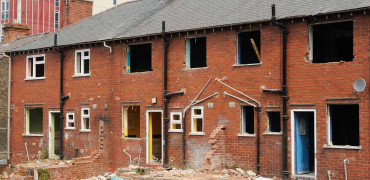The impact of global warming has become so evident in the past year that even the most sceptical of climate change deniers are having to sit up and take notice.
Future housing policies are coming to the forefront of actions we need to take in order to avoid a looming catastrophe.
The north west of America and the tourist coastline of Turkey have both been racked by huge fires, which have been burning out of control, while large parts of western
Europe suffered extensive rainfall and destructive flooding in recent weeks.
The destruction of forests and natural habitat will take many decades to recover from, while thousands of homes and hundreds of lives have been lost.
Closer to home in Britain, last year was officially the third warmest, fifth wettest and eighth sunniest on record, according to scientists reporting in the latest UK State of the Climate report.
Scarily no other year is in the top 10 on all three criteria. The experts said that in the space of 30 years, the UK has become 0.9C warmer and 6 per cent wetter.
These changes are having dramatic consequences all around us.
Getting heat pumps in rented homes represents a significant challenge
Climate changes affect our housing
The report's lead author Mike Kendon, climate information scientist at the UK Met Office, said: “A lot of people think climate change is in the future, but this proves the climate is already changing here in the UK. As it continues to warm we are going to see more and more extreme weather such as heatwaves and floods.”
Underlining this point, a separate report from the British Geological Survey (BGS) is warning that the climate crisis is putting millions of homes (mainly in south east and east England) at increased risk of subsidence as hotter and drier summers are causing the ground under our houses to shrink and crack.
The key areas affected are London, Essex, Kent, and a swathe of land from Oxford up to the Wash. This is because the clay formations underlying these areas are most vulnerable to losing moisture.
In a medium scenario for future emissions, the area of Great Britain that is highly or extremely likely to see increased risk of clay-related subsidence increases by a third from 2020 to 2030 and triples by 2050.
The projections show about a million homes were at risk of subsidence in 1990 and this rises to 2.4 million in 2030 and 4 million in 2070. London is the most affected, with nearly half of the capital’s homes at increased risk in 2030 and 57 per cent in 2070, according to BGS.
“It is a very clear message,” said Anna Harrison, at BGS. “The south-east gets a double whammy, in that they’ve got susceptible geology and much drier, warmer summers are projected there.”
The subsidence risk projections could be used as a planning tool, she said, to highlight areas where the foundations of new houses may need to be deeper to avoid future problems.
Challenges, threats and opportunities
All of this information is pointing in one direction and leading to a single conclusion – we need to make serious life-changes now, before it becomes too late.
This is posing enormous challenges to the whole of the construction sector, from planners to developers and those involved in the change of use of existing buildings. The cost of doing nothing, or not enough to make a real difference, is almost too much to contemplate.
Amid a flurry of recent energy policy statements (linked to the above) the Government has stated that all private rented sector homes should be improved to EPC band C by 2028 and that ALL homes in the UK should be EPC band C by 2035 where practicable, cost effective and affordable.
Currently two thirds of UK homes fall below the average band C, on the rating scale of A to G.
The latest report from the English Housing Survey tells us that the average cost of bringing a privately rented dwelling up to EPC band C is £7,646. This compares to £5,979 for a social rented dwelling, or £8,579 for owner-occupied homes.
The total estimated costs of bringing all 2.9 million privately rented dwellings in England that are currently EPC D or lower, up to EPC band C is a staggering £21.5 billion and we have no indication of where this money will come from or who will be responsible for paying for this work.
And of course many of these homes are in the south east of England, with London having the highest rate of private rental properties in the country at double the national average – adding to concerns over the impact of subsidence and the cost of works to alleviate this.
Increased role for heat pumps
Most of the identified works to improve energy ratings in private rentals were taken up by various forms of insulation improvements (in walls and lofts, installing double glazing and new external doors, etc) and in renewing water and space heating systems.
With gas boilers being targeted for replacement at increasing rates and gas prices forecast to soar by the year-end, the main types of new ‘acceptable’ heating systems are air, ground and water sourced heat pumps and hydrogen boilers.
The latter has yet to satisfy all of the understandable safety concerns, so most industry attention is on heat pumps.
Heat pumps make use of heat from an external source (air, ground or water) and have the potential to provide heating using less energy than traditional systems.
Being electrically powered, they also have the potential to be low carbon if the source of that electricity is itself low carbon.
According to the English Housing Survey (EHS), less than one per cent of the English housing stock or 103,000 dwellings have a heat pump for space and/or water heating.
Of these 103,000 dwellings with a heat pump, 50 per cent were owner occupied, 23 per cent were owned by housing associations and 16 per cent were owned by local authorities.
The proportion of homes with a heat pump in the private rented sector was too small for a reliable estimate to be used in the EHS report.
Getting heat pumps installed in these rented homes over the next 10 years represents a significant challenge.
Exponential growth required
Heat pumps are more common in the rest of the UK, but even so, less than a quarter of a million of the UK’s 29 million homes currently have heat pumps.
In 2019, 27,000 new heat pumps were installed – compared to the 100,000 additional homes connected to the gas network and the 1.7 million replacement boilers installed. Over 70,000 installations are expected in 2021.
This means that heat pumps account for less than 2 per cent of the market in the UK.
Compare this position with Norway where over one third of households have heat pumps and they account for 95 per cent of new heating installations.
The Prime Minister’s Ten Point Plan for a Green industrial revolution sets out an ambition to install 600,000 heat pumps per year by 2028, while the Scottish Government is targeting a peak of 250,000 renewable heat installations a year in the 2030s, of which the majority are likely to be heat pumps.
Meanwhile the Climate Change Committee has suggested that 3.3 million heat pumps need to be installed in existing homes by 2030, rising to eight million by 2035 to reach net zero targets.
This equates to one million installs per year in new and existing homes by 2030, which suggests that the level of ambition will need to increase.
Added benefits
Scaling up the heat pump sector is vital for achieving net zero – and presents both a challenge and an opportunity. There are more than four million homes in England now using oil, coal, LPG and less efficient electric heating that would benefit from being retrofitted with low carbon heat pumps as a first priority.
An added benefit with some heat pumps is that they can be re-set to act as air conditioning units. Being able to cool down in the hotter summer months is going to become a bigger challenge, particularly for older households who are more at risk of ill-health due to excessive heat.
According to the EHS, by far the most mentioned method to keep homes cool among households was to open the windows (93 per cent). The next most common methods were switching on a fan (45 per cent) and closing the curtains (42 per cent). The least common methods mentioned were switching on air conditioners (2 per cent) and unrolling the awing or canopy (1 per cent).
Using heat pumps as air conditioning units could be a simpler solution to this particular problem, while also solving the carbon emissions conundrum.
Patrick Mooney is editor of Housing Management and Maintenance magazine



